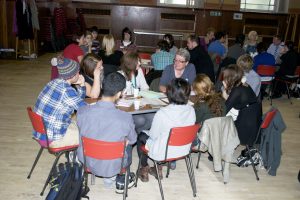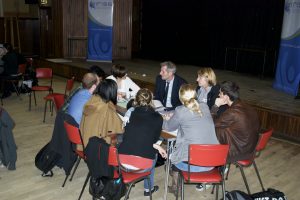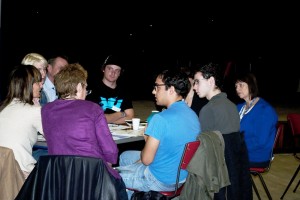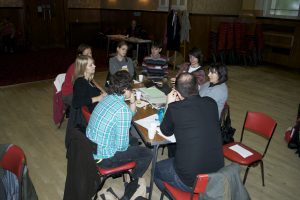Today, in a beautiful building in the south side of Glasgow, 15 practitioners working with older people from across the social services, and 20 students from the Glasgow School of Art came together to begin to think about reshaping the future choreography of care and support for older people in Glasgow South.
This work aims to complement that of the Reshaping Care for Older People agenda and is all about empowering practitioners to come together, to think about the services that they provide differently and to come up with new ideas and ways of working that might provide better outcomes for the people receiving support in this area. Practitioners were from social work services, health, the private sector (Bupa care home) and the voluntary sector (Cornerstone Care).
The new ideas bit, is where the students come in to lend a hand. The 20 students, in their third year at the art school, are busy honing their service design skills and are bringing with them fresh perspectives, creative skills and visualizing capacity. Throughout this project we hope to marry the innovation that is already happening on the front line, with the new tools and methods of service design to help the practitioners work in partnership to develop ideas for the future.
We’ll also be introducing the students to older people and their carers so that they can get a better picture of their lives from their perspective (more about that on Wednesday), and to ensure that anything that is produced through the project is truly co-produced.
The Launch
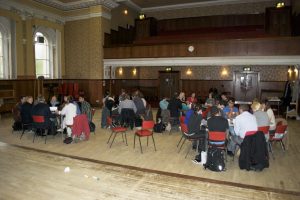
Today marked the start of a 7 week project, where these participants will be coming together in 4 teams to focus on the following themes:
- reablement
- partnership working and communications
- anticipatory care – specifically non-admittence to hospital
- social isolation
We spent time today splitting the students and practitioners into groups, ensuring there was an even spread of experience across each team. Getting to know each other, making sure everyone was on an equal platform, and introducing some of the issues that practitioners are facing was the order of the day.
We presented the policy direction and ethos of the project to the students and asked each team to consider their given theme and to discuss their commitment to the project and the types of elements that they’d like to explore. The commitments were as follows:
1. committed to thinking about partnerships with clients and familes and communicating well with family members
2. committed to the priority of maintaining the couple’s independence and protecting the individual’s right to make choices and to be heard
3. committed to assessing the needs of both the carer and the service user, promoting their indpendence but also increasing their awareness of their options.
4. committed to listening to people and considering the person as an individual (removing any labels) and working together to shape the care and support that the person receives.
After lunch, we gave the teams time to consider the practicalities of how they wanted to go forward as a group, as well as thinking about potential site visits, and information requests. We then all discussed each of the approaches as a group. These were as follows:
Anticipatory Care Team
This team is thinking about how the students will integrate into each of the different sites. They have decided that one student will visit the Bupa care home at a time (to ensure that this does not become overwhelming for the residents). The rest of the students will visit Elder Park (health setting) and Langton Road (social work setting), whilst coordinating this through telephone and email.
Communication and Partnership working Team
This team has decided to create a blog and a facebook group so that they can share ideas readily with each of the other team members (more information on this soon). They want to learn a bit more and get some more information before coming back together as a group – planning to look at the whole process and how each of the different sectors interact with one another.
Reablement Team
This team are planning to meet to create a map of all the different services that exist locally for older people – from a reablement perspective. They also will plan to make visits to the different workplaces. The students and practitioners have given each other homework (!) – each group identifying what they would like to know about the other, as well as becoming clear on the expectations of what they can deliver as a group.
Social Isolation Team
This team will be meeting tomorrow at social work premises to get a better feel for this type of role and the responsibilities that come with it. This will include looking more closely at individual rights, assessments and meeting needs. The students will then be invited to the other settings to get a grasp of things from their perspectives.
What’s next?
Over the next seven weeks the teams will have the opportunity to meet with different groups of older people and their carers, visit different work settings and ask lots and lots of questions as the basis for developing ideas as a team. These ideas will be consistently subject to refinement following group sessions where all project participants come together to get feedback on their ideas.
The teams will be posting up discussion about what has happened including their thoughts, ideas and processes to this blog so keep your eyes peeled for more information soon…. We are really pleased with the start of the project and are excited to see what will happen throughout the seven weeks!
All comments welcome.
*IRISS would like to thank our partner organisations NHS Education for Scotland (NES) and the Scottish Social Services Council (SSSC) for allowing us use of elements from their ‘Sliding doors to Personal Futures’ events. The SSSC and NES are taking forward the workforce agenda part of the Reshaping Care for Older People programme; looking at the kind of workforce we will need in the future, the skills workers will need and how to support future learning.
